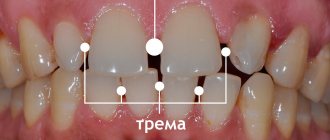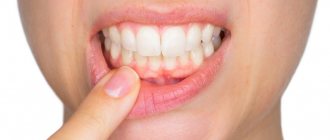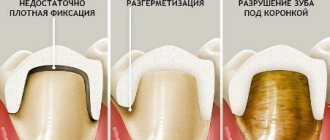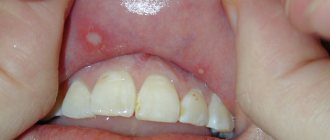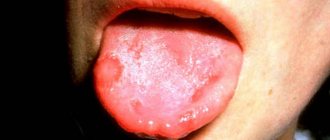All people have experienced an unpleasant taste in their mouth at some point in their lives. In most cases, this phenomenon is temporary and does not indicate any diseases or pathological conditions. But the taste of iodine may not go away for a long time. When faced with such a situation for the first time, many people are in no hurry to contact a specialist and try to figure out this problem on their own. However, such a feeling in the mouth is a reason to go to the doctor.
- 5 Treatment
- 6 Treatment prognosis and possible complications
- 7 Prevention
- 8 Features in women
What does the taste of iodine in the mouth mean?
In most situations, a special taste of iodine in the mouth indicates an excess of the microelement of the same name in the body. An excess can form due to many reasons, and a doctor can help identify the primary disease, a sign of which is an excess of iodine in the human body. There are standard values for iodine intake. To maintain the full functioning of the body, it is necessary to consume up to 300 mcg of iodine per day. The maximum safe daily dose is 500 mcg. Excess iodine in the body is called iodism.
Video about excess iodine in the body
If the unpleasant taste in the mouth appears suddenly, then there is a possibility that it will go away soon. It is possible that the use of various iodine-containing foods or medications could influence the appearance of this sensation. It is worth understanding that both insufficient and excess iodine content negatively affects human health. Such deviations most strongly affect the child’s body.
Iodine is a very important trace element and is necessary for the full functioning of the human body. With its help, the thyroid gland produces special hormones that affect metabolism, mental productivity, human development and growth.
Main features
The composition of water in a well depends on seasonal changes and external influences. To control the quality of an underground source, you need to regularly do research. There are 4 signs that will warn you about the need to disinfect a well.
Color change
Pure water is always clear, without any shades. If the liquid turns green, then the moisture “blooms”. When direct sunlight enters the mine, algae and bacteria begin to multiply and develop. Colonies of microorganisms in the form of tiny balls can be seen with the naked eye.
Black water in a well is the result of rotting organic matter. Due to the decomposition of leaves, animal carcasses, insects or birds, substances are released that contaminate the moisture. Decomposition products are poisonous to living beings, so the liquid must be disinfected.
Yellow or brown color of water in the well warns of high iron content. The element reacts with air, causing rust to occur. The substance can be either in the liquid itself or in the metal parts of the structure (pipes, filter).
Color change Source serovglobus.ru
Yellow water occurs in wells that were dug in violation of technology. Shallow homemade wells are located in layers with a high concentration of sand or clay. Poor sealing of the seams between the rings of the structure leads to the penetration of impurities and staining of moisture.
Turbidity and sediment
Violation of transparency warns of the need to disinfect the water in the well. Sticky silt forms on the walls of the well or fine dust collects, which makes the liquid cloudy. The problem appears after rain when the tightness of the structure deteriorates.
If the pump is installed incorrectly, the transparency of the water in the well is impaired. The distance from the bottom to the suction part of the device should be within 70-80 cm. If the device is installed incorrectly, then upon startup it will raise sediment. The liquid becomes cloudy and sediment forms, which must be removed.
Reasons for opacity Source stroymore.ru
An oil film above the surface of the water in a well warns of oil products entering the well. A rainbow spot occurs when the seams on the walls are depressurized or when the pump fails. Often the cause is a gasoline lighter that fell out of the owner's pocket and ended up in a mine shaft.
Foreign odor
Biological or chemical processes in a well manifest themselves as aromas in the water. When organic matter decomposes, hydrogen sulfide is released, and the liquid acquires the aroma of rotten eggs. The moisture is not dangerous to humans, but due to the smell it is impossible to drink and use for household needs.
If garbage constantly gets into the well, the water smells like rottenness or swamp. Mechanical impurities settle to the bottom, where decomposition occurs. In the early stages, the liquid does not become cloudy or change color. An unpleasant aroma and the presence of splinters (sticks) warn of contamination of the source.
Unpleasant amber of water Source watertestingkits.com
If the moisture in the well smells like detergent, gasoline or phenol, this indicates the presence of wastewater in the aquifers. Unnatural odors appear when chemical products come into contact with them. Hazardous components from sediments entered underground sources.
Taste of water
A metallic taste in well moisture indicates the presence of iron in the composition. Sourness is a sign that water is in contact with bronze or copper parts in the well. Increased salt content manifests itself in the form of brackish water. Bitterness warns of contamination from domestic wastewater.
Unusual taste of water Source yandex.ua
Why does the taste of iodine appear in the mouth and what does it mean?
There are several reasons why iodine tastes. In some cases, various diseases can lead to this symptom:
- diseases of the thyroid gland, which cause excessive production of thyroid hormones containing iodine;
- disturbances in the gastrointestinal tract;
- liver diseases;
- kidney disease;
- disturbances in the functioning of the sweat glands;
- destruction of tooth enamel or installed fillings, due to which oxidation of the remaining parts of the teeth occurs;
- allergic reactions to iodine.
Diseases of the thyroid gland can lead to the appearance of an iodine taste in the mouth
In addition to diseases, the taste of iodine can be caused by the use of various foods, medications, as well as exposure to various external factors.
- Living in an area with poor environmental conditions. In this situation, chronic poisoning with iodine occurs, which accumulates in the body throughout the entire time spent in the unfavorable zone.
- Uncontrolled intake of medications and vitamin preparations containing large amounts of iodine. This can lead to an overabundance of this substance in the body.
- Taking hormonal medications, which can also disrupt iodine metabolism in the body. Oral contraceptives, when used for a long time, can lead to hormonal imbalance in women.
- Eating stale fish with dark meat. It could be tuna, mackerel, mackerel. In this situation, histamine poisoning occurs.
- Iodine poisoning in various industrial processes. There are standards that establish a safe amount of iodine in the work area; it should not exceed 1 mg/m3.
- Eating large quantities of seafood, seaweed and other foods that contain iodine.
Seafood can lead to excess iodine in the body
In some situations, various diagnostic procedures can provoke the appearance of an iodine taste in the mouth. During computed tomography, magnetic resonance imaging, and ultrasound, special contrast agents with a high iodine content are sometimes used, which are injected into blood vessels or internal organs. Thanks to them, a more detailed study of the body is possible. Immediately after the substance enters the body, people usually feel a warmth spreading throughout the body and a metallic taste in the mouth.
Also, sometimes the taste of iodine in the mouth can be a consequence of various neurological and psychological problems that cause taste hallucinations. Most often, the cause is serious shocks, stressful conditions and nervous tension.
Video about hyperthyroidism in Elena Malysheva’s program “Live Healthy!”
Preparation for processing
The quality and speed of cleaning depends on the preparatory procedures. Before the event, liquid is pumped out of the well. A household surface apparatus can handle a small volume of water. When there is a significant level of moisture, a submersible model is lowered into the shaft. To prevent debris from getting into the device, floating debris is collected with a net or a net with a long handle.
Scoop out dirty water Source build-experts.ru
Before disinfecting water in a well, you need to check the reliability of the structure. A man on a cable descends into the well and carefully examines the walls. Silt, sediment, and algae are removed from surfaces using hard brushes and spatulas of various sizes. Leaks and cracks are sealed with a solution with waterproofing properties. Mold is disinfected with copper sulfate.
The remaining water from the bottom is scooped out with a bucket. The bottom of the well is thoroughly cleaned of sediment, the old bottom filling is removed and replaced with a new composition. Due to its low weight and toxicity, expanded clay is contraindicated as a filter. For the well use:
- river gravel;
- small crushed stone;
- sand.
The shift of the lower rings occurs due to the influence of quicksand. The rupture areas are treated with cement mortar. Displacement of the upper structures occurs after the ground freezes. The parts are held together with fasteners made of thick, strong wire.
Restoring seam sealing Source kolodcy-pod-klyuch.ru
Plaque on the concrete rings of the well must be removed. Mechanical tools and chemicals are used to eliminate it. Salt deposits can be removed with acid-based substances. Corroded spots are removed with a jackhammer or leveled with a grinder. The cleaned metal is treated with a waterproof anti-corrosion solution.
Symptoms
Symptoms vary significantly depending on the cause of the iodine taste in the mouth. If the provoking factor was poisoning or an excess of a trace element in the body, then patients may experience the following symptoms:
- With mild negative reactions, some report slight dizziness, nausea, headaches, and skin rashes. Sometimes pain in the abdominal area, weakness, and thirst are added.
- Moderate reactions lead to more severe skin rashes and urticaria. Some patients experience heart rhythm disturbances, low or high blood pressure. Also, the voice may become hoarse, breathing sometimes becomes difficult, shortness of breath and increased salivation appear. There is a burning sensation and sharp pain in the throat.
- A severe reaction of the body to an excess of iodine can have an extremely negative impact on the patient’s condition. Blood pressure sometimes drops to a critical level, convulsions appear, the throat swells, and breathing becomes impossible. In some cases this can be fatal.
Patients with thyroid diseases may suffer from obesity, they experience swelling more often than usual, their mood often changes, and irritability is noted.
Why does an unpleasant taste occur after a series of diagnostic procedures?
Iodine-containing substances are now widely used for research purposes as ultrasound contrast media and radiopaque agents. They are used to take better pictures inside the body in tests such as X-rays, magnetic resonance imaging, computed tomography, and ultrasound.
Contrast agents containing the natural chemical element iodine can more accurately identify abnormalities. These are injected into arteries, veins, discs, fluid spaces of the spine and other body cavities. In this case, the contrast blocks or limits the ability of ultrasonic waves or x-rays to penetrate.
As a result, organs, blood vessels and other body tissues into which contrast was injected change their appearance, which is clearly visible in the photographs.
The reasons for the unpleasant taste may lie precisely in the introduction of contrasting materials.
The consequences of this phenomenon can have different severity:
- Contrast agents used during the above diagnostic studies may cause mild negative reactions: nausea ending with vomiting, headache, itching, mild skin rash;
- Moderate reactions include hives or severe skin rash, wheezing, abnormal heart rhythm, low or high blood pressure, shortness of breath or difficulty breathing;
- Severe reactions include: convulsions, decreased blood pressure, swelling of the throat. Some patients suffer from difficulty breathing. Cardiac arrest is also possible.
Immediately after the administration of an iodine-containing substance, a person feels a surge of heat and an unpleasant metallic taste for several minutes.
It is very rare, but it still happens that the patient experiences a so-called delayed-type reaction, accompanied by a rash and lasting several days.
Most of these conditions do not require medical intervention, but in severe cases of rashes, treatment under the supervision of doctors is necessary.
Diagnosis and differential diagnosis
If the taste of iodine in the mouth appears very often or does not go away within several days, you should consult a doctor to carry out the necessary diagnostic procedures. It is best to make an appointment with an endocrinologist. In the future, if necessary, he will give a referral to see a doctor of a different profile. During the initial examination, an anamnesis is collected (a set of information about the development of the disease, living conditions, past diseases, etc.), the patient’s professional activity is clarified, and the skin and mucous membranes are examined. The following studies are also required:
- general blood analysis;
- Urinalysis helps identify excess iodine in urine;
- blood test for thyroid and pituitary hormone levels;
- the ICP AES method allows you to determine the iodine concentration in a small part of the nail plate;
- Atomic emission spectrometry determines the amount of iodine by measuring the wavelength of light emitted by the trace element.
How to determine quality
Signs of infection indicate the need to clean the water in the well. To begin eliminating the problem, you need to identify the culprit. Laboratory analysis will help identify the cause of contamination. Research is carried out by sanitary and epidemiological stations, accredited centers of Rospotrebnadzor or private companies with a license.
Liquid studies Source stroy-podskazka.ru
Water from the well is poured into a clean glass or new plastic bottle with a volume of 1.5 liters. The liquid is carefully added to the container, otherwise excess oxygen will form inside due to the strong pressure. The reservoir is tightly sealed, wrapped in dark polyethylene and delivered to the laboratory within 3 hours.
The result is a conclusion about the organoleptic characteristics and qualities of the well. Experts summarize whether the well is suitable for use for household and food purposes, and prescribe recommendations for improving the water.
Treatment
In most cases, a person does not require any special treatment; the taste of iodine in the mouth quickly disappears when the provoking factors are eliminated. If the cause of this symptom was any disease of the internal organs, then the doctor, depending on the diagnosis, will prescribe comprehensive treatment to the patient. In case of poisoning, gastric lavage may be performed.
If taking medications is to blame, you must stop using them. The doctor will select a suitable replacement for those drugs that provoked the appearance of the taste of iodine in the mouth. If the cause was various stresses and overexertion, then sessions with a psychotherapist can have a beneficial effect on the patient’s emotional state and, over time, relieve him of the unpleasant symptom.
If conventional drug therapy for hyperthyroidism does not bring positive results, the doctor may prescribe treatment with radioactive iodine or surgery.
Drug therapy
You should not self-medicate, as this can lead to a serious deterioration in your health and the development of various complications. All medications are selected individually by the attending physician based on the diagnosis and condition of the patient.
- Antithyroid drugs that reduce the hormonal function of the thyroid gland are necessary for hyperthyroidism (Thiamazole, Carbimazole, Propylthiouracil).
- Beta-blockers are necessary to eliminate the symptoms of hyperthyroidism, such as rapid heartbeat, high blood pressure (Anaprilin, Atenolol, Betaloc, Metoprolol).
- Sorbents help remove excess various compounds from the body (Enterosgel, Polysorb).
- Sodium thiosulfate and calcium chloride are a kind of “antidote” for poisoning with iodine-containing products. They are used directly in hospitals under the supervision of doctors.
- Bromine acts on the same receptors as iodine, inhibiting its effect on the body. Due to these properties, bromine preparations are actively used when there is an excess of iodine in the body.
- Sleeping pills are necessary for sleep disorders and nervous tension (Donormil, Valemidin).
- Anxiolytic drugs help eliminate anxiety and nervousness (Afobazol, Mexidol, Teraligen).
- Antidepressants are prescribed for a long-term depressed emotional state (Azafen, Sibazon, Paxil).
- The doctor can prescribe tranquilizers for acute mental conditions that the patient is not able to cope with on his own (Phenazepam, Relanium).
Preparations for eliminating the taste of iodine - photo gallery
Anaprilin is used in the treatment of high blood pressure Afobazol - a mild sedative Enterosgel removes toxins from the body
Diet
Since the diseases that can lead to the appearance of an iodine taste in the mouth are quite specific, doctors give special recommendations to many patients. They must be followed to reduce the content of this trace element in the body. It is necessary to exclude or limit as much as possible the consumption of the following products:
- seafood and sea fish;
- seaweed;
- iodized salt;
- other iodine-containing vegetables and fruits.
To accelerate the removal of iodine from the body, it is useful to consume eggs, milk, starch-based jelly and various vegetable oils.
If there is an excess of iodine in the body, you should avoid consuming iodized salt.
Folk remedies
Some herbal preparations can be used for various diseases that lead to excess iodine in the body. Before using any product, you should consult your doctor, as there are contraindications.
Recipes based on zyuznik
Zyuznik is a very effective plant for the treatment of various diseases associated with hyperfunction of the thyroid gland. It helps normalize the emotional background and stabilizes blood counts. There are several recipes that can be used for hyperthyroidism.
Preparation of the decoction:
- Take one teaspoon of the crushed plant, pour it with one glass of clean drinking water and boil for ten minutes.
- Cool the broth, strain and drink 50 ml three times a day for a week.
Preparation of tincture:
- Collect the top leaves of the sage and add alcohol to them in a ratio of 1:10.
- Pour into a glass bottle, close with a strong lid and leave to infuse for two weeks in a cool, dark room.
- Filter the resulting tincture.
Drink the resulting product once a day, ten drops, with a glass of water. Each week, increase the daily dose by five drops. Having reached the maximum dosage of 40 drops per day, begin to gradually reduce the dosage to the original portion and stop using the product.
Zyuznik is effective in the treatment of diseases associated with hyperfunction of the thyroid gland
Tincture with white cinquefoil
White cinquefoil (popular names: five-fingered, five-fingered, five-fiddled) is a common herbal remedy used for problems with the thyroid gland. The herb regulates its activity and helps normalize the functions of the organ. Five-finger is used for hyperthyroidism, thyrotoxicosis and nodular formations. The plant has a beneficial effect on the synthesis of thyroid-stimulating hormone by the pituitary gland. You can prepare a medicine from white cinquefoil according to the following recipe:
- To make a pentafala tincture, you need to prepare the roots of the plant, wash them thoroughly and chop them.
- The resulting mass is poured with alcohol in a ratio of 1:10 and left for thirty days in a dark room.
Drink 20 drops diluted in two tablespoons of water fifteen minutes before meals. The course of treatment is one month, followed by a break of two weeks, and the procedure is repeated.
White cinquefoil normalizes the function of the thyroid gland, both stimulating it and reducing it
Disinfectants
Disinfection of water in a well is carried out with special preparations with disinfectant and antibacterial properties. Well products must destroy pathogenic microflora, quickly erode or disintegrate into components that are safe for people. There are 9 methods that can be used at home.
White
An inexpensive, simple option is used to disinfect a well. A chlorine-based chemical is suitable for a moderately neglected well. Take 1 liter of the drug per ring of the structure. The product is poured over the walls from the bucket, the surface is thoroughly smeared with a brush on a long pole. If you have a garden sprayer, it is easier to spray the disinfectant liquid.
The well is covered with thick cloth or polyethylene, left for a day in cold weather, and for 10 hours in warm weather. Ultraviolet radiation should not enter the well, otherwise the bleach will disintegrate under the influence of the sun. The absence of the smell of "Whiteness" in the mine indicates the destruction of the chemical. To disinfect the structure, the procedure must be repeated.
Bleach for disinfection Source remontkit.ru
After disinfection of the well is completed, the walls are washed with chlorinated liquid, then with clean liquid. The water is pumped out until the smell of the drug disappears. The moisture in the well cannot be used for drinking for 7-10 days.
Lime
One percent chlorine comes in the form of a white powder. The product in plastic bags of various packaging can be purchased at hardware or construction stores. To prepare the essence, 10 g of the substance is dissolved in 1 liter of pure liquid. To disinfect water in a well, take 400 ml of the prepared solution per 1 m3 of moisture in the well.
Chlorine for wells Source plesneveet.ru
If the structure is small, then the chemical liquid is poured into the source along the walls. A large shaft is treated with a special stick with a brush or sponge at the end. Manipulations are carried out for 10 minutes, after which the well is covered from the sun with a film (thick cloth). In summer, 6 hours of disinfection is enough; in autumn or early spring, the lime is left for 12-24.
Upon completion of the procedure, the chemical solution is thoroughly washed off the walls of the well. The moisture is pumped out until the chlorine odor disappears. As with Belizna, the liquid will become suitable for drinking after 10 days.
Treatment prognosis and possible complications
The prognosis for treatment in most situations is positive; almost all patients get rid of the taste of iodine in the mouth within a few days. If a person consults a doctor in a timely manner, the chances of a speedy cure increase significantly.
It is worth understanding that a large amount of iodine in the body can lead to all sorts of disruptions in the functioning of internal organs. With an excess of this microelement, the destruction of protein structures begins, which causes damage to the kidneys, liver, central nervous and cardiovascular systems. In acute poisoning, in which a person has consumed about two grams of crystalline iodine, death occurs quickly. In less severe cases, the following complications may occur:
- burns of mucous membranes;
- swelling of the upper respiratory tract, suffocation;
- allergic reactions;
- anaphylactic shock.
Drug treatment of iodine odor from the mouth
Initially, it is necessary to eliminate the cause of the smell. In case of poisoning by a substance through the respiratory system or orally, immediate first aid is required. The first step is to rinse the stomach so that the maximum amount of iodine leaves the body. When carrying out the procedure in a medical facility, doctors use the following drugs:
- Sodium thiosulfate antidote. The drug is recommended for poisoning the body with iodine vapor, arsenic, bromine. It should not be used by pregnant or breastfeeding women. May be taken orally or intravenously. The dosage is prescribed by the doctor. When used, an allergy may occur, so it is necessary to keep the patient under control.
- Medicines prescribed for cardiovascular problems. Cordiamine, camphor. Cordiamine is prescribed to stimulate the respiratory system. It is administered subcutaneously or intramuscularly. Used together with novocaine for pain relief. A side effect of use may be seizures. If the poisoning has caused difficulties with the respiratory system and, as a result, a cough, the doctor will prescribe medications containing caffeine, codeine, and dionine. Medicines are used intravenously. An attack of bradycardia, fever, redness of the skin are side symptoms of the use of antitussive drugs.
- Inhalation with water and ammonia, soda is prescribed for iodine poisoning through the respiratory tract. It is recommended to rinse the throat, mouth and nose with a 2% soda solution.
Prevention
Prevention of the appearance of an unpleasant taste of iodine in the mouth is the moderate consumption of iodine-containing foods and medications, as well as the exclusion of harmful professional activities. Also, for persons prone to diseases of the thyroid gland and gastrointestinal tract, periodic examinations by doctors are required in order to promptly cure any pathologies that have arisen. If patients are prescribed medications containing iodine, then drinking alkaline carbon dioxide water and sodium carbonate will be beneficial. It is necessary to avoid the use of alcohol during treatment with any drugs.
Also, you should not use medications with iodine for children under five years of age, unless they are prescribed by a doctor.
Liver diseases
The smell of iodine from the mouth in the morning is a typical sign of exacerbation of chronic liver pathologies. They can be caused by eating fatty foods or drinking alcohol the night before. Characteristic symptoms include a jaundiced tint of the skin and sclera, pain in the right hypochondrium.
The liver is the body's natural filter. Due to insufficient neutralization of toxic substances, a person begins to feel regular drowsiness, irritability, and muscle weakness. Possible diseases include chronic hepatitis, cirrhosis, and neoplasms in liver tissue.
Features in women
In women, the most common cause of iodine taste in the mouth is the use of oral contraceptives. Under no circumstances should you select medications of this kind on your own, relying on recommendations from friends or advertising. Each person’s body is individual, and those medications that are suitable for one person can cause irreparable harm to another person. Long-term use of hormonal contraceptives can affect the state of the endocrine system.
Oral contraceptives can lead to serious hormonal imbalance
If the taste of iodine in the mouth does not go away within several days and patients are bothered by other unpleasant sensations in the body, then this may be an indication of serious diseases of the internal organs. It is very important to consult a doctor in time and follow all his recommendations. It is worth adjusting your diet, monitoring your health and undergoing preventive examinations with an endocrinologist and gastroenterologist.
Washing machine Hotpoint-Ariston VMSL 501 B, white
15699 ₽ More details
Washing machine Candy CS34 1052DB1/2-07, white
16099 ₽ More details
Electrolux washing machines and dryers
Gastrointestinal lesions
An iodine smell and taste on the tongue may indicate increased Klebsiella activity. Normally, this bacterium is present in the intestinal microflora in small quantities. The process of increased proliferation of Klebsiella, caused by weakened immunity or prolonged use of antibiotics, is accompanied by a specific aroma from the mouth.
The spread of opportunistic bacteria leads to digestive disorders, the development of diseases of the genitourinary system and pneumonia. For treatment, you need to contact a gastroenterologist.
Associated symptoms
In cases of iodine vapor poisoning, symptoms usually appear quickly and disappear within 1-2 days. In this case, the symptoms are considered:
- runny nose and cough;
- swelling and rupture of the salivary glands;
- skin damage.
When a large amount of iodine is consumed orally, irritation of the throat, pharynx, and respiratory tract occurs , as well as dysfunction of the gastrointestinal tract. The following symptoms appear:
- bad breath for a long time;
- nausea, vomiting;
- change in mucous color to blue;
- burns of the esophagus, stomach, mouth;
- kidney damage.
Iodism may also be accompanied by the following symptoms:
- body temperature above 38ºС;
- constant feeling of thirst;
- general weakness;
- skin rash;
- rhinorrhea and increased secretion of saliva;
- intestinal disorders (nausea, vomiting, diarrhea).
With hyperthyroidism, in addition to the iodine taste, the following symptoms may appear::
- tachycardia;
- increased sweating;
- irritability;
- weakness;
- depressive states;
- headache;
- digestive disorders.
